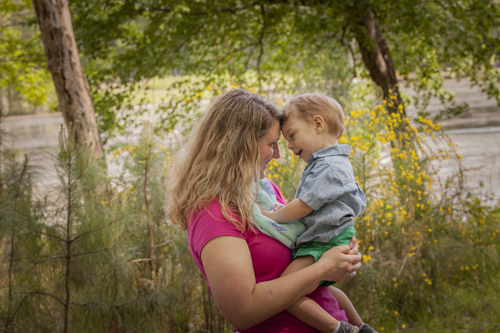CHKD's craniofacial team helps Tucker – and his family – through surgery.
Like most proud mothers, Kristin Bond of Newport News has taken many photos of her 2-year-old son, Tucker. While snapshots of her toddler’s sweet grin bring a smile to her face, the photos that she shares most often are those that chronicle Tucker’s surgery and recovery at CHKD when he was just 5 months old.

When Tucker was born at Sentara Williamsburg Regional Medical Center on July 19, 2013, doctors immediately noted the elongated shape of his head – a telltale sign of a birth defect called craniosynostosis. Kristin left the hospital with a referral to Dr. Joseph Dilustro, a pediatric neurosurgeon at CHKD, for an evaluation.
“It was overwhelming,” says Kristin. “As a new mom with a newborn baby, it was terrifying news to get because I didn’t know what it meant for Tucker’s health and future.”
Craniosynostosis affects the growth and shape of the skull. A newborn’s skull is made up of five bony plates with joints – also called sutures – between them. These sutures are open at birth to accommodate the rapid growth of the brain, and normally grow together between the ages of 2 and 3. Craniosynostosis occurs when one or more of the plates grow together prematurely and the suture becomes closed. When this happens, the skull becomes misshapen and, in some cases, brain development can be affected.
During an evaluation at CHKD, Dr. Dilustro diagnosed 4-day-old Tucker with the most common form of craniosynostosis – sagittal craniosynostosis. “In this type, the suture that runs along the top of the child’s skull – from the soft spot on the top of the head to the back of the head – has fused closed, causing the child’s skull to bulge in the front and back of the head,” he says.
Dr. Dilustro explained that, because the bones of the skull are still soft in infants, the optimal treatment would be surgery before Tucker’s first birthday, ideally between 4 and 6 months of age. Dr. Dilustro and pediatric plastic surgeon Dr. Jesus Gil B. Inciong, medical director of CHKD’s craniofacial surgery program, would perform the delicate operation together with the support of a comprehensive craniofacial team including pediatric anesthesiologists, surgical nurses and intensive care specialists.
“While the surgery is very specialized, Tucker’s correction was a straightforward case,” says Dr. Dilustro, who performs approximately 25 craniosynostosis surgeries a year.“ CHKD has been doing both simple and complex craniofacial surgeries for more than 30 years, and we have a highly experienced team of specially trained pediatric medical professionals and resources to provide excellent care and outcomes for kids.”
In fact, the well-known charity, Operation Smile, which provides free craniofacial reconstruction surgery to children all over the world, regularly collaborates with CHKD on cases that are especially complex, bringing many international patients to the hospital for surgery and follow-up care. And like many other dedicated CHKD physicians and staff members, Dr. Inciong is a long-standing Operation Smile volunteer.
To help prepare Kristin for her son’s surgery, Karen Via, nurse coordinator of the craniofacial program, recommended that she meet other families who had been through craniosynostosis surgery at CHKD. When Kristin connected with another family, she was able to see photos of the child taken at the hospital. “Seeing those photos really helped me feel prepared,” Kristin says.
On the day of Tucker’s surgery in December of 2013, Kristin was touched by the extra effort CHKD’s medical team made to put her at ease. “When they were ready to take Tucker to surgery, they let us take him back to a certain point. Then the doctors carried him back in their own arms,” Kristin says. The memory of Tucker being carried away in the arms of his medical team still brings tears to her eyes.

The six-hour procedure began with Dr. Dilustro carefully removing the skull bones in the front and on the top of Tucker's head, separating the bone from his brain. When his portion of the surgery was complete, Dr. Dilustro came out to the surgery waiting room to give Tucker's family an update in person and reassure her that the surgery was going well. "Waiting an hour is a lot easier than waiting six hours, and it meant a lot to have Dr. Dilustro come out personally to talk to us,"Kristin says.
Once the bones of the skull were detached, Dr. Inciong provided the reconstructive surgery to cut the bones of the skull that had been fused together. He then reshaped the bones and put them in place to allow them to grow and fuse together normally.
Remembering how much it helped her to see photos of another child’s recovery, Kristin took lots of pictures to document her son’s recuperation, creating a photo album to share with parents of children facing similar surgeries. As a way to pay it forward, she hoped the photos would give others special insight into the experience and lessen the anxiety parents feel about the procedure.
Tucker spent his first day in CHKD’s pediatric intensive care unit. “During those first days, his eyes were swollen shut. I remember thinking how glad I was that he was too young to walk. My voice and my touch were very comforting to him,” says Kristin. He was moved to a regular patient room by the second day of his stay and able to open his eyes by the third day after surgery. On day five, Tucker went home with a bandage on his head but a smile on his face.

Today, Tucker’s surgery is a distant memory – the fine scar on his scalp is strategically hidden under a crop of strawberry-blond hair. The photo book that illustrates his recovery is shared in the craniofacial program to help other families prepare for their child’s surgery. “Since creating the album, we’ve shared it with a dozen other families, and it really offers them an advantage as they prepare for surgery,” says Via. “To be able to see another child’s journey – when they can see the child is doing so well – is extremely comforting for parents.”
Contributing to the book was also a way for Kristin to be able to thank the craniofacial team for the excellent care Tucker received at CHKD. “We’re so fortunate to live near CHKD and have this amazing resource for our children,” says Kristin. “I’m forever grateful.”